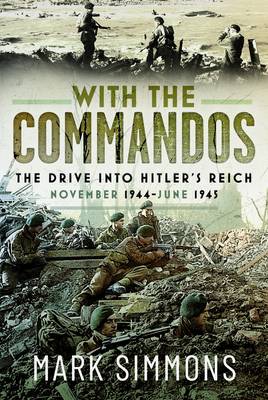
- Afhalen na 1 uur in een winkel met voorraad
- Gratis thuislevering in België vanaf € 30
- Ruim aanbod met 7 miljoen producten
- Afhalen na 1 uur in een winkel met voorraad
- Gratis thuislevering in België vanaf € 30
- Ruim aanbod met 7 miljoen producten
Zoeken
With the Commandos
The Drive Into Hitler's Reich, November 1944-June 1945
Mark Simmons
Hardcover | Engels
€ 34,95
+ 69 punten
Omschrijving
On 4 September 1944, Allied forces and local resistance fighters captured the Belgian port of Antwerp, the largest harbour in Europe. Once opened to Allied shipping, the port would revolutionise the Allies' delivery of supplies into mainland Europe, stores which were still having to make the long overland journey from Normandy and places such as Cherbourg. But to enable this to happen, the Scheldt Estuary and, more importantly, the island of Walcheren also needed to cleared of Hitler's forces.
The task of storming and liberating the heavily defended island of Walcheren was handed to the men of the Commandos. Under Operation Infatuate, the plan was to land Commandos at Westkapelle and Flushing, and have the Canadians push across the Walcheren Causeway. Launched on 1 November 1944, Operation Infatuate was the last and one of costliest Combined Operations attacks of the Second World War in Europe. Such was the bitter nature of the fighting, in one sector alone, out of twenty-eight landing craft deployed, only five survived touchdown.
Despite the Allies' victory, the fighting was far from over for the Commandos. Indeed, a number of them were rushed to help fill the lines during Hitler's Ardennes offensive - the Battle of the Bulge. Despite the urgency of such a move, many of the Commandos felt they were wasted undertaking what they considered to be an infantry task, and should have reverted back to their original raiding role. In fact, the 4th Commando Brigade did find itself on the River Maas line until the end of the war in Europe, while the 1st Commando Brigade was called upon to lead the advance across a number of major rivers into the very heart of Germany. Starting with the mighty Rhine, the Brigade used its specialist amphibious skills as assault troops before advancing on across the Weser, Aller, and Elbe rivers, all of which was only achieved after much hard fighting.
With the Commandos tells a story which has been largely forgotten, namely that of the Commandos' role in the last few months of the war in Europe. It was a period when, following D-Day and the Normandy landings and subsequent breakout, these men battled their way into the heart of Third Reich fighting against a fanatical foe.
The task of storming and liberating the heavily defended island of Walcheren was handed to the men of the Commandos. Under Operation Infatuate, the plan was to land Commandos at Westkapelle and Flushing, and have the Canadians push across the Walcheren Causeway. Launched on 1 November 1944, Operation Infatuate was the last and one of costliest Combined Operations attacks of the Second World War in Europe. Such was the bitter nature of the fighting, in one sector alone, out of twenty-eight landing craft deployed, only five survived touchdown.
Despite the Allies' victory, the fighting was far from over for the Commandos. Indeed, a number of them were rushed to help fill the lines during Hitler's Ardennes offensive - the Battle of the Bulge. Despite the urgency of such a move, many of the Commandos felt they were wasted undertaking what they considered to be an infantry task, and should have reverted back to their original raiding role. In fact, the 4th Commando Brigade did find itself on the River Maas line until the end of the war in Europe, while the 1st Commando Brigade was called upon to lead the advance across a number of major rivers into the very heart of Germany. Starting with the mighty Rhine, the Brigade used its specialist amphibious skills as assault troops before advancing on across the Weser, Aller, and Elbe rivers, all of which was only achieved after much hard fighting.
With the Commandos tells a story which has been largely forgotten, namely that of the Commandos' role in the last few months of the war in Europe. It was a period when, following D-Day and the Normandy landings and subsequent breakout, these men battled their way into the heart of Third Reich fighting against a fanatical foe.
Specificaties
Betrokkenen
- Auteur(s):
- Uitgeverij:
Inhoud
- Aantal bladzijden:
- 288
- Taal:
- Engels
Eigenschappen
- Productcode (EAN):
- 9781036145798
- Verschijningsdatum:
- 28/04/2026
- Uitvoering:
- Hardcover
- Formaat:
- Genaaid
- Afmetingen:
- 159 mm x 235 mm

Alleen bij Standaard Boekhandel
+ 69 punten op je klantenkaart van Standaard Boekhandel
Beoordelingen
We publiceren alleen reviews die voldoen aan de voorwaarden voor reviews. Bekijk onze voorwaarden voor reviews.








